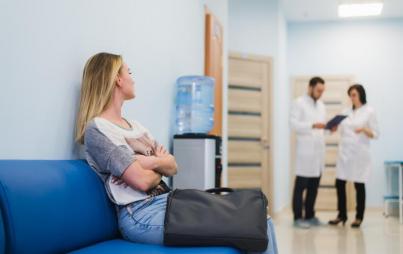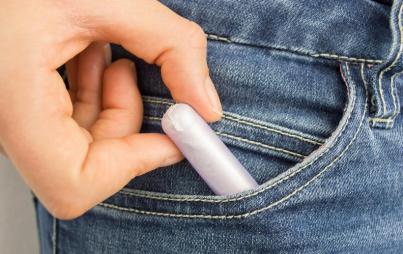
I didn’t just have to deal with the physical trauma of the fibroids and surgery, but the emotional fallout of dealing with potential infertility so early in my life.
This article first appeared on The Refresh and has been republished with permission.
In early 2005, I was in the middle of graduate school, planning my career, and thinking about the fabulous life I had ahead of me. What I wasn’t thinking about was my health. I ate well, was physically fit, and it didn’t occur to me that anything could possibly be wrong. Even the continuous spotting I had been living with for two years didn’t make me pause. Not until I casually mentioned it to a friend.
“You’ve been spotting every day for two years?” she asked me incredulously.
“Yeah. Is that a problem? I thought it was just because of the pill I’m on.” I admit, I wasn’t all that concerned. I didn’t feel sick, and I didn’t look sick, so what could possibly be wrong?
At her insistence, I went to see my family doctor. After a series of tests and ultrasounds, I found out that I had a very large fibroid in my uterus, and because of the continuous spotting the fibroid had caused, I was now dangerously anemic.
The Canadian Women’s Health Network (CWHN) defines fibroids as “benign tumors that grow in, on, or outside of the wall of the uterus.” Fibroids are also sometimes medically referred to as “leiomyoma” or simply “myoma."
While the exact cause of fibroid growth remains a mystery, data seems to show a relation between fibroid growth and estrogen production.
There is also a strong genetic link, and a woman whose mother had fibroids is three times more likely to have fibroids herself, compared to a woman with no family history of the condition.
The CWHN notes that up to 75 percent of women of childbearing age will get fibroids, and approximately 25 percent of women will suffer from fibroids that are symptomatic and require treatment or removal.
After the fibroid was discovered, I was referred to an obstetrician/gynecologist (OBGYN), who determined that the size and side effects of the fibroid warranted its removal as soon as possible. There are several ways to deal with fibroids surgically, and for my case, the best option was a hysterotopic resection, a procedure that involves using a special electrical loop to remove the fibroid in small pieces. This procedure can leave scar tissue in the area of the uterus where the fibroid was, potentially rendering it unable to sustain a fertilized egg should one try to implant there. Additionally, this method of fibroid treatment doesn’t prevent fibroids from re-growing. But at the time, it was my best bet.
You Might Also Like: I Didn't Know Uterine Fibroids Ran In My Family Until I Had Them
I had the surgery, and went on with my life. I didn’t have any further problems until February 2009. That month, my period was extremely heavy, and even though I didn’t have any pain, I knew that something was terribly wrong. After three days, two calls to TeleHealth Ontario and two trips to the hospital – the last one by ambulance — it was discovered that I had another large fibroid in my uterus that had burst, and caused me to hemorrhage. After more tests, ultrasounds and two blood transfusions, it was determined by a team of doctors that I would require another resection.
I remember the doctor sitting next to my hospital bed talking me through the surgery. She suggested that if I wanted to get pregnant, the best time to do it would be during the first year after the procedure. At that point, I was only thirty-one years old, and in a new relationship. Having children in the near future was the furthest thing from my mind. I knew that I wanted children someday, but having one within the next twelve months seemed impossible to me. In that moment, I realized that having children may not be in the cards for me, but I didn’t feel like I had any options, so I went ahead with the surgery.
All the stress took its toll on me. I didn’t just have to deal with the physical trauma of the fibroids and surgery, but the emotional fallout of dealing with potential infertility so early in my life. I feel very fortunate that my then-boyfriend was completely supportive. He let me know in no uncertain terms that my fertility wouldn’t be a factor in our relationship. My health was his primary concern, and we’d worry about kids if and when that time came. Ultimately, he and I did get married. And exactly two years after our wedding, I gave birth to a healthy baby girl. But I didn’t know at the time how it would all work out. I just knew that my future could be dictated by what was happening to me in that moment, and I couldn’t control it.
A study published in the American Journal of Obstetrics and Gynecology found that almost 90 percent of African American women and 70 percent of white women will develop fibroids by the time they are 50 years old, and the National Institute of Health reports that almost all women who are newly diagnosed with fibroids will seek medical or surgical treatment for the condition in the first year.
Fibroids can cause anemia, pain, heavy menstrual bleeding and infertility.
The Department of Obstetrics and Gynecology at the UCLA reports that fibroids are one of the leading causes of hysterectomies in the United States. This condition can seriously impact the lives of women and their families as they deal with symptoms, surgeries and recovery. And yet, as educated as women are on diabetes, cancer, heart disease and other conditions, fibroids remain on the back burner of the conversation, though they are prevalent in the lives of so many people.
As women, we need to take a more active role in our health care, and keep ourselves informed on the things that will impact our health and our lives. Speak to your doctor when something seems off, and learn about the things that will impact you. Your health is in your own hands.








